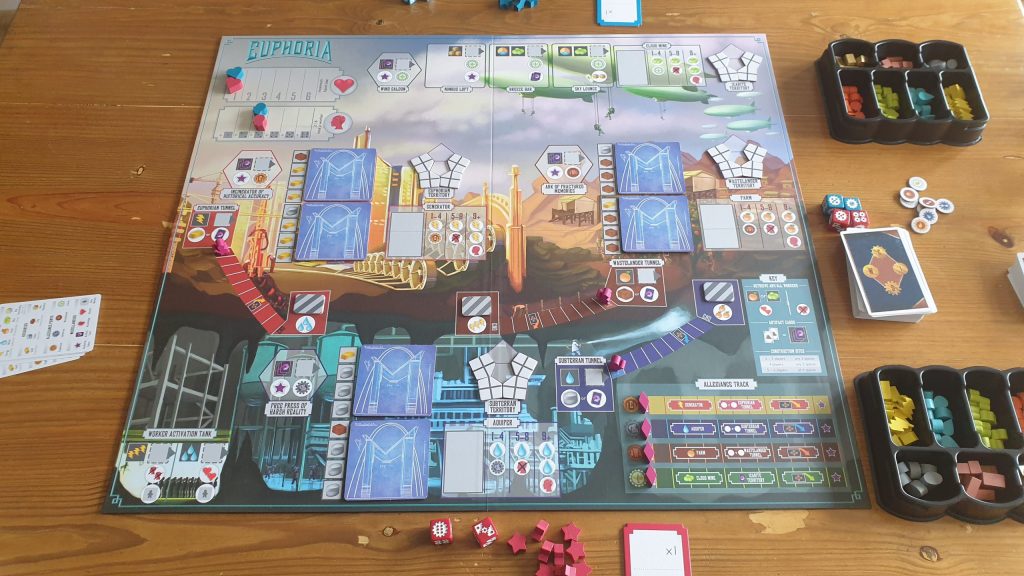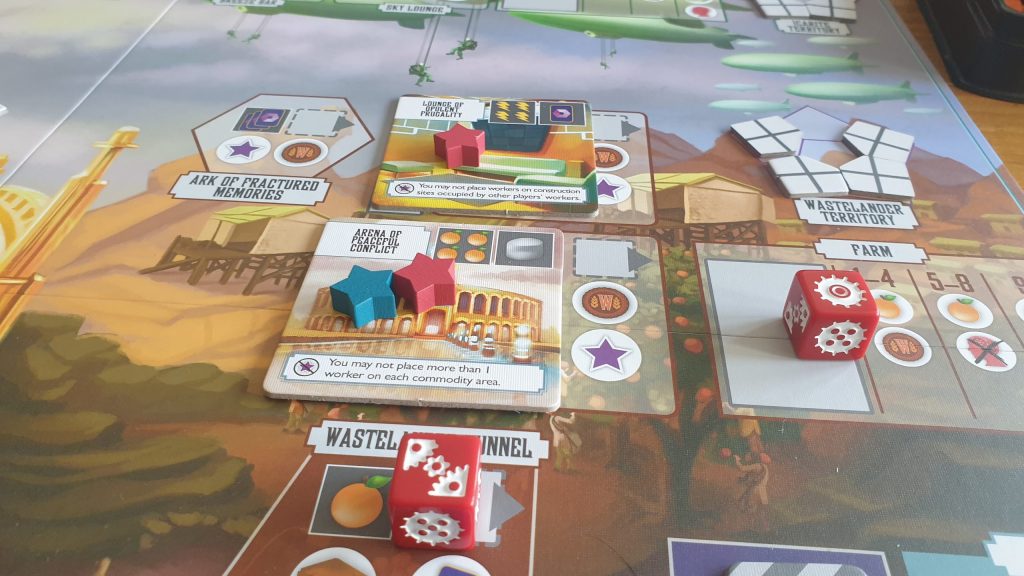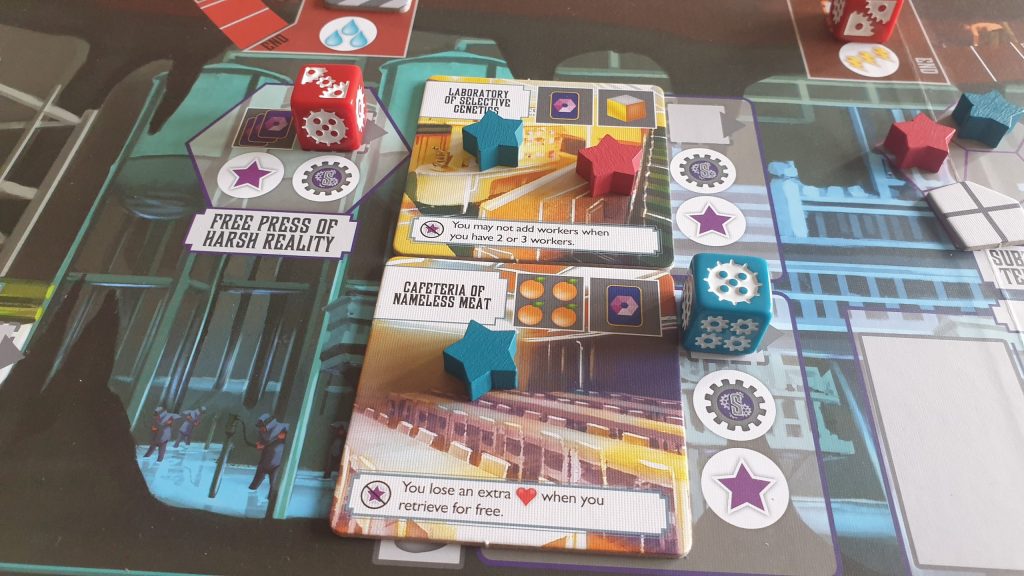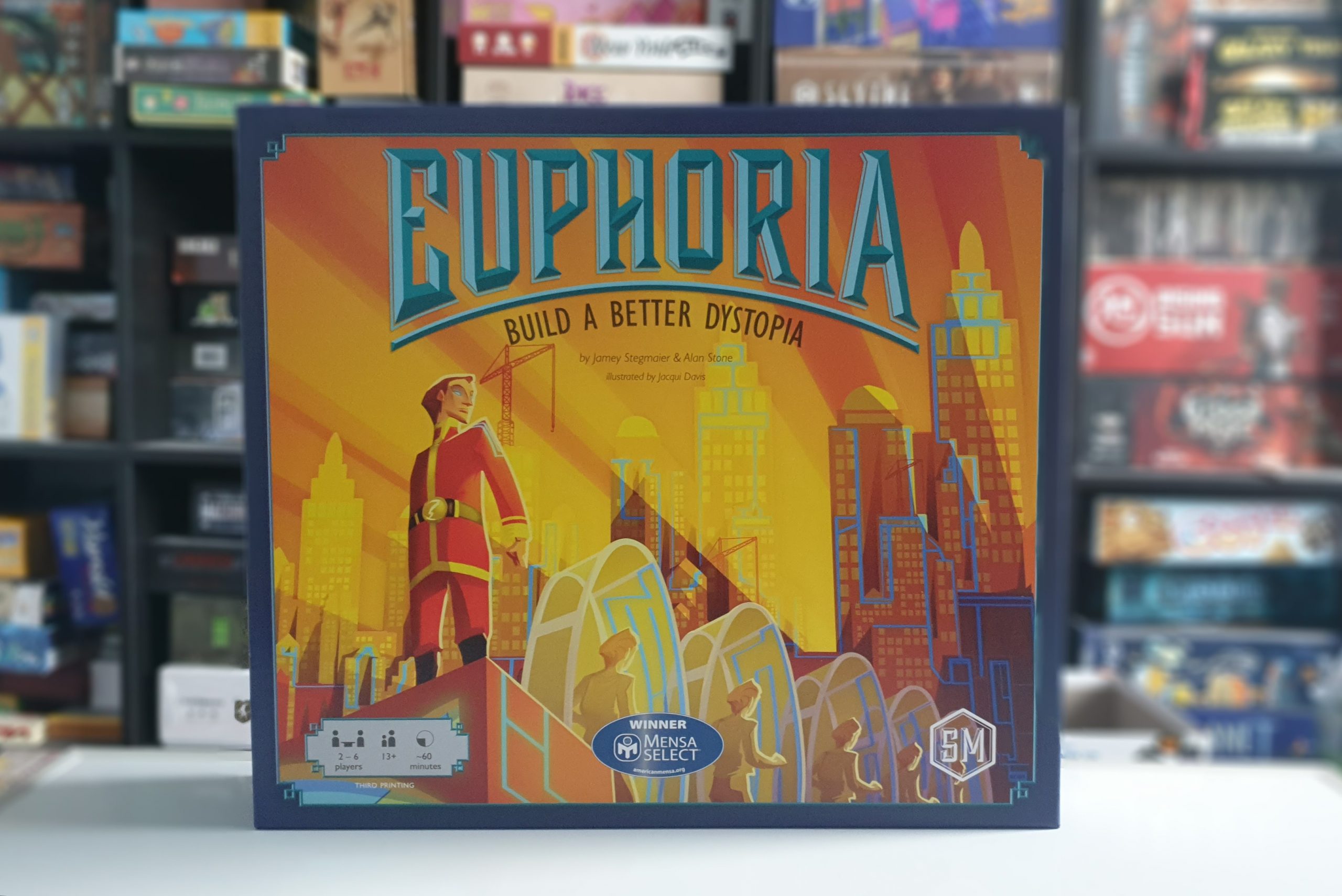Euphoria: Build a Better Dystopia is a dice based worker placement game from publisher Stonemaier Games. Designed by Jamey Stegmaier and Alan Stone, featuring artwork from Jacqui Davis, the game sees 2 – 6 players trying to get a slice of the dystopian future, whilst keeping their workers oblivious to what’s going on. Originally released back in 2013, the latest version now also features a Game Trayz insert. However, will players feel euphoria after they learn all about the dystopia? Let’s find out!
With the Game Trayz full of resources, these just need to be lifted out of the box. Each player then claims the dice and authority stars of their chosen colour, keeping two dice and placing the other two in a pool for later. Players place a knowledge token of their player colour onto the midpoint of the knowledge track, and a morale token on the lowest spot of the morale track. With the recruit and artifact decks shuffled each player then gets four recruits cards to choose from, keeping one as an active recruit and one inactive (facedown).
Taking it in turns players will be placing or retrieving dice. While there are turns in Euphoria, there are no set rounds. There are various areas that players can send workers to, with some returning different resources based upon the die value. Commodity areas allow players to obtain 4 separate commodities: energy, water, food and bliss. These are found in the four board sections Euphoria, Subterra, Wastelands and Icarus respectively.
These commodity areas are the only spaces that can have an unlimited number of dice on them. The amount of a commodity earnt is based upon the total dice value after your worker has been added. When the combined value is 4 or lower, players gain 1 resource of the specific type and advance the faction’s token on the allegiance track. Between 5 and 8 will see the player gain 2 resources and lose knowledge. With a total of 9+ 2 resources are earnt with knowledge gained. This sees the value of going to these spaces dynamic and situationally beneficial or problematic.

Three of the faction areas have mines, with the zeppelin based Icarites the faction without one. These are temporary use spaces, where the value of the worker doesn’t matter. These style spaces are not blocked. Any player can bump a dice there, sending it back to its owner, to take the action. Going to a mine advances the miner token on the mine and awards a choice of a resource or an artifact card – artifact cards being needed for some action spaces. Eventually these can trigger inactive recruits to become active and even open up special resource slots for players with active recruits from a faction.
There are 2 types of markets that players can send dice to, either artifact markets or constructed markets – which start out as construction sites. To use a construction site players will need to send workers to a number of slots adjacent to a facedown market tile. These spaces are not temporary, therefore these workers cannot be bumped. When enough spaces for the player count are full the dice are returned and the market is constructed. Players that got dice back can put one of their authority stars onto the tile for helping building it. When this occurs players that don’t have an authority star on the constructed market will be hampered by an on-going negative effect. These penalties range from losing resources when rolling numbers on their worker dice to being unable to bump your own workers.
Constructed markets and artifact markets can both be visited to place an authority star on an available space on the associated faction’s territory. Artifact markets also allow authority stars to be added to their faction’s constructed markets in case a player didn’t help build it, to stop the on-going penalty.
As players only start with two dice they will have to retrieve workers from the board. This can be performed when a player has at least 1 die on the board, taking up their entire turn. Players can retrieve as many dice as they wish – though at least 1 must be retrieved. Players can pay food or bliss when retrieving to gain morale, else some morale is lost. Morale determines the number of artifact cards a player can hold – so this can see them have to discard cards. Whenever players gain dice back they must be rolled, with a knowledge check triggered. Combining the value of your available dice and your knowledge this value is compared to a maximum of 16. If too high your highest valued die must be discarded – effectively your workers became too knowledgeable about their situation.

New worker dice can be obtained, up to a total of 4, allowing more actions to be performed between retrieving. The more dice players have the higher the risk they will become too knowledgeable – though placed dice don’t count towards the knowledge test. To counter this, with more workers there is a higher chance of rolling doubles. In Euphoria if a player has two workers of the same knowledge value both can be placed in a single turn.
Players will be trying to push factions up the allegiance tracker. As well as unlocking bonuses along the way, when a faction hits the end of the tracker all revealed recruits of that faction gain an authority star. Alongside this players will be trying to construct markets and claim territories to get rid of their 10 stars. The winner is the player who manages this first, via whatever means they managed. Ties are possible, with allegiance tracks triggering authority stars for multiple players. These are split by the most morale, lowest knowledge and most constructed market stars.
Euphoria looks more complicated than it is. This is at the detriment of getting the game to the table with some whom may otherwise enjoy it. Rather than having uniform patterns for the faction sections the commodity zones are dotted around, with the constructed markets and territory zones in completely different sub areas. For example, for the Icarites the artifact market and territory are almost at either end of the board. For the rest they are only a box away. When you look past this the individual elements of the markets, commodity areas and more are of consistent design though.
Iconography is often used to alleviate issues of learning or remembering lots of terminology. It does accomplish this but only after playing the game, and this isn’t helpful when learning it. The board iconography does little to remind players the difference between the two types of markets. With artifact markets allowing a player to put authority stars onto two different locations, while constructed markets only allow stars to be added to territories, there is quite a difference. Issues of the user interface on the board don’t stop there. The iconography used for temporary spaces, with costs in an adjacent box, and one-time use spaces, with the costs on them, isn’t consistent. Both feature a cost, so a similar style could have been used, with the arrows and dashed/solid lines enough to differentiate them.

The recruit cards add a source of variable player powers into the mix. Unfortunately, a number of the powers are seemingly balanced for a higher player count, meaning that at 2 players and sometimes at 3 there are standout amazing abilities. A selection of recruits allow the player to gain bonus resources for placing the only or lowest knowledge worker at a location. With less players the chance of this occurring is vastly increased. The sole other player can try to interrupt these plans but it feels like an uphill battle. With more players more dice are added to the board between turns, covering more locations. Then, these types of abilities become more situational like the rest. Another issue with the lowest player count is the way markets are constructed. Whenever a player goes to a construction site you almost feel forced to go there, as to not suffer the ongoing penalty. With more players having the odd debuff feels like it can be worked around but at 2 it is amplified as your opponent won’t have the same problem.
Any game with dice, and even a card deck, are prone to luck. Some games attempt to mitigate the luck. Rajas of the Ganges did a great job at making dice of all values useful. Different values allow different things in the commodity areas. Still, mostly a high pip value is worse – with very little to impact a rolls result available to players. There are also a selection of constructed market tiles that result in players losing resources based on the value of their dice when rolled. Being something that is completely out of players’ control I will happily leave those specific tiles in the box, never to be used again. The other market tiles can be punishing but there are often ways to work around their negative effects. They might impact a strategy but leave the choice in players hands not the hands of the dice gods.
Including Game Trayz is a nice way to make a game look nicer in the box, yet it doesn’t always translate to a practical improvement. Thankfully, those included in this latest edition of Euphoria make setup smoother, and are even useful during play – being utilized as resource containers. Splitting the resources across the two included smaller sections of the Game Trayz allows all resources to be within reach by all around the table, without the need for additional chit pots. Surprisingly though there aren’t any instructions as the best way to utilize or sort the components in the Game Trayz. Some elements like where the dice go is obvious. The rest is only learnt by finding images of what others have done on sites like Board Game Geek or during the first play as it becomes apparent what is needed.
Stonemaier Games’ titles are often referred to as efficiency puzzles, and Euphoria fits that description. While players start with different powers from their recruits, it is all about getting the most from the workers – without them becoming too knowledgeable. The decks, dice, randomised constructed markets tiles and more instill elements of randomness. While most won’t ruin a strategy there are parts that are outside of players control, though this becomes less noticeable with more players. The game lasts a little too long for the amount of luck, as it is frustrating at times to be on the unfortunate side roll after roll. A few additional ways to mitigate luck and I could see many more enjoying the game. Sadly it falls into the category of games to play a couple of times and move on from.
(Editor’s Note: Euphoria: Build a Better Dystopia was provided to us by Asmodee for the review. The game is currently available from local board game stores, some of which are reopening! Find your local store here.)

